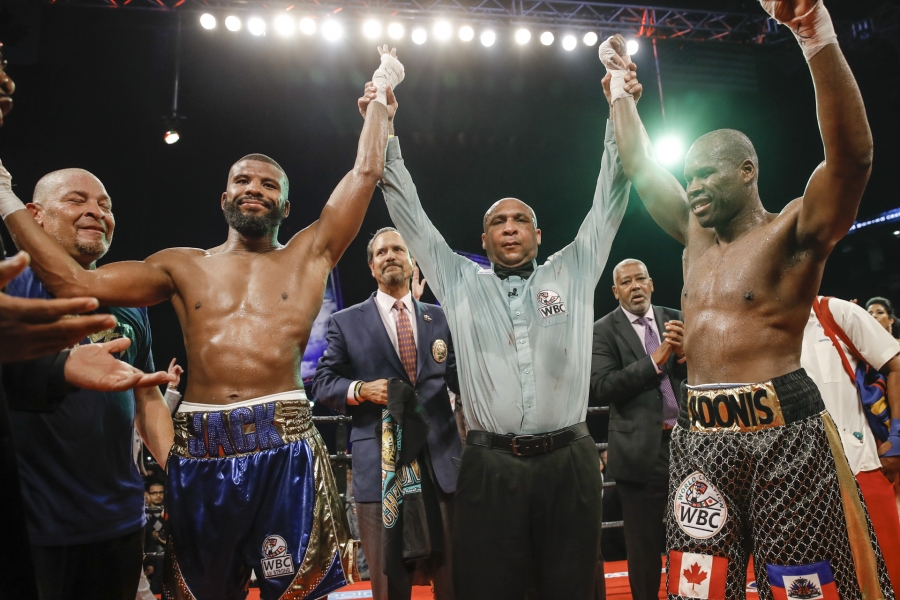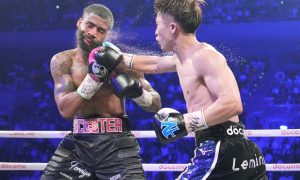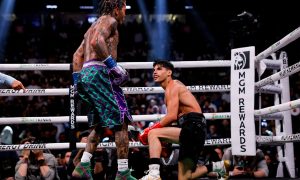
In a sport with too many titles, there is one belt boxing fans hold close to their heart: the lineal championship.
Before Adonis Stevenson fought Badou Jack to a majority draw this past Saturday night, the Haitian-born champion said, per ESPN, “I’m the king at Light Heavyweight. I beat the king to become the king.” Stevenson—a ferocious puncher with a criminal past and reputation—earned the lineal championship, a notional crown, in June 2013 when he knocked out Chad Dawson in one round (Dawson defeated Bernard Hopkins for what Bad Left Hook called the “true” championship of the world, and Hopkins, Jean Pascal)—“the man who beat the man who beat the man.”
In November 2015, The Ring stripped Stevenson of their own championship belt, once synonymous with the lineal title itself, fed up with the Canadian transplant’s reluctance to face his top competition, namely Sergey Kovalev. The publication instituted a championship policy in 1922, awarding Heavyweight Jack Dempsey their first belt.
Boxing never actually had one universally-recognized throne. The World Boxing Association (WBA) traces its roots back to 1920 under the name National Boxing Association (NBA). As far back as 1915, the New York State Athletic Commission (NYSAC) and the International Boxing Union (IBU) also enthroned world champions.
Ninety-six years since The Ring wrapped a belt around Dempsey—who was vicious but failed to meet his two top contenders (Harry Greb; Harry Wills)—boxing fans have been consistently exhorted to believe that, in a sport with too many titlists, the solution is yet another champion. But a legitimate one, just like Stevenson was until he wasn’t.
Sunday afternoon in Japan, hours after Saturday’s Showtime broadcast, Hekkie Budler—a firecracker from South Africa, formerly a Strawweight, known for changing his hair color before every fight—overcame eight-to-one odds to dethrone Ryoichi Taguchi for the IBF, WBA, and The Ring Junior Flyweight titles in the defending champ’s backyard. Taguchi, who has a giant frame for the 108-pound division, won the magazine’s vacant belt in 2017 over Milan Melindo.
That same year, however, Ken Shiro, another Japanese fighter who weighs 108 pounds in fighting trim, decisioned world-ranked fighters Pedro Guevara and Ganigan Lopez. The Transnational Boxing Rankings Board (TBRB), an ensemble of respected writers and historians, dissented from The Ring’s opinion, ranking Shiro, accordingly, the No. 1 Junior Flyweight in the world. Shiro has a stronger resume; Taguchi met just one ranked opponent (Melindo) before losing to Budler.
After the “Bible of Boxing” sold its soul to Golden Boy Promotions, a handful of the ratings advisory panel eventually resigned, and helped found the TBRB. Their mission statement cites the board’s initiative: “To provide boxing with authoritative top-ten rankings [and] identify the singular world champion of every division.” They’ve accomplished the former, at least, but not the latter.
TBRB only recognizes four true champions (including Stevenson) in a sport made up of 17 weight classes. The 13 vacancies, though, could not be more insignificant considering ESPN’s expanded boxing coverage and Matchroom Sport’s announced venture into the United States.
The Guardian published a chronicle of TBRB’s emergence as the preeminent boxing rankings, stating, “At the core of all sports is the desire to know who is the best, who is the champion, and, of course there should be only one.” It’s always a problem comparing boxing to organized sports where the winner is measured by objective rules: the number of made baskets or scored runs. Champions in major American sports are decided only after an annual playoff tournament—impossible for boxing.
Boxers, above all else, are prizefighters, working as hard or consistently as somebody is willing to pay them. ESPN’s Eric Raskin put it this way: “Money is the ultimate matchmaker in boxing.” So trying to compel fighters to constantly participate in the most competitive bouts is like asking them to follow rules to a game they’re not playing.
The lineal championship seems satisfying until its structure encourages the neuroses that convinced Stevenson he’s the lord of a division housing destroyers like Kovalev, Dmitry Bivol, and Artur Beterbiev. Because it’s the wish of most fight fans to know who’s champion—not the best, or the most accomplished—but the champion, Stevenson remains the Light Heavyweight kingpin, sequestered above the entire class, for one win half a decade ago. Exactly what fans asked for.
Pointing to a singular champion absolves the fan from closely following any other boxer in the division. If a contender hasn’t been in the ring with the king, he has no claim. Simple. But when these theoretical thrones are vacant—as 13 are today—there is still and always will be a premier fighter in the class. Some better than others, to be sure.
When TBRB saw no lineage at Junior Flyweight, they still concluded Shiro was No. 1. If Shiro refuses to ever fight another notable name again, eventually someone below him will build a resume of more quality and relevant wins to usurp the divisional leader, the same way Kovalev compiled a better ledger than Stevenson by 2016. Boxing fandom, though, drive themselves mad when the two top-ranked combatants don’t dance. It’s great when it happens, the sport persists when it doesn’t.
The need for some governing body to affirm a champion emanates from a bygone era, when the most committed followers of the sport were limited to the radio, newspaper recaps, or theater reproductions. Past fights weren’t so readily available on YouTube nor was it possible to stream live title fights from across the globe to a laptop.
Last weekend, Budler’s victory was free to watch by anybody stateside on the website Fuji TV and can now be found online. Those who tuned in were treated to a career-defining performance by perhaps the most tenacious brawler in boxing—something there isn’t a belt for. Junior Flyweights are especially worth watching, as are so many other divisions ignored by HBO and Showtime. On May 25, viewers can see for themselves when Shiro and Lopez rematch, to be broadcast by ESPN+, in support of the bantamweight contest between Naoya Inoue and Jamie McDonnell.
World titles never make up for the action that precedes them. Few recall, or care about, what belts were on the line when Muhammad Ali and George Foreman rumbled in the jungle. In fact, after losses to Joe Frazier and Ken Norton, Ali wasn’t lineal champion at the time or the first part of the 1970s, the decade called the Golden Age of Heavyweight Boxing. But by the end of the era, Ali mastered them all.
In 1922, The Ring called Dempsey Heavyweight champion of the world but didn’t acknowledge Harry Wills—”The Black Panther,” who at the time had legitimately lost just once in his previous 64 bouts. The historian Matt McGrain, of Boxing.com, drew another lineage, writing, “Wills superseded Sam Langford as the dominant black Heavyweight.” McGrain continued, “Dempsey never defeated a Heavyweight as special as Wills, nor even one as special as Langford.”
Denied glory by the prejudice of the time, neither Wills or Langford claimed lineal or alphabet titles, according to the archives at Cyber Boxing Zone.
They may be remembered for being the most talented of fighters to never win a championship, but Langford—who triumphed over Hall of Famers from Lightweight to Heavyweight—is considered by the proper historian, not just among the greatest to ever lace up a pair of gloves, but maybe the greatest ever.
No matter how linear or universal a title another boxer ever held.
Header photo by Esther Lin/Showtime










